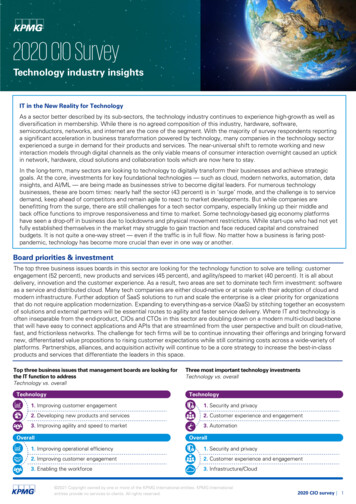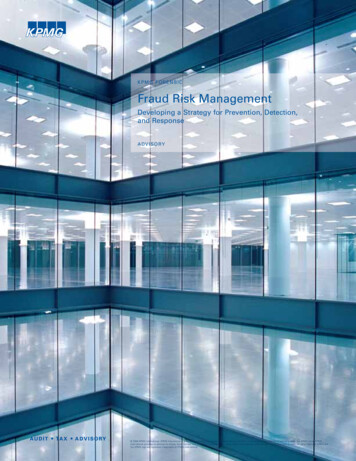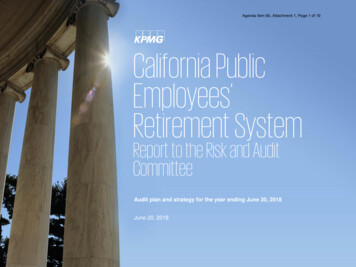
Transcription
2020 CIO SurveyTechnology industry insightsIT in the New Reality for TechnologyAs a sector better described by its sub-sectors, the technology industry continues to experience high-growth as well asdiversification in membership. While there is no agreed composition of this industry, hardware, software,semiconductors, networks, and internet are the core of the segment. With the majority of survey respondents reportinga significant acceleration in business transformation powered by technology, many companies in the technology sectorexperienced a surge in demand for their products and services. The near-universal shift to remote working and newinteraction models through digital channels as the only viable means of consumer interaction overnight caused an uptickin network, hardware, cloud solutions and collaboration tools which are now here to stay.In the long-term, many sectors are looking to technology to digitally transform their businesses and achieve strategicgoals. At the core, investments for key foundational technologies — such as cloud, modern networks, automation, datainsights, and AI/ML — are being made as businesses strive to become digital leaders. For numerous technologybusinesses, these are boom times: nearly half the sector (43 percent) is in ‘surge’ mode, and the challenge is to servicedemand, keep ahead of competitors and remain agile to react to market developments. But while companies arebenefitting from the surge, there are still challenges for a tech sector company, especially linking up their middle andback office functions to improve responsiveness and time to market. Some technology-based gig economy platformshave seen a drop-off in business due to lockdowns and physical movement restrictions. While start-ups who had not yetfully established themselves in the market may struggle to gain traction and face reduced capital and constrainedbudgets. It is not quite a one-way street — even if the traffic is in full flow. No matter how a business is faring postpandemic, technology has become more crucial than ever in one way or another.Board priorities & investmentThe top three business issues boards in this sector are looking for the technology function to solve are telling: customerengagement (52 percent), new products and services (45 percent), and agility/speed to market (40 percent). It is all aboutdelivery, innovation and the customer experience. As a result, two areas are set to dominate tech firm investment: softwareas a service and distributed cloud. Many tech companies are either cloud-native or at scale with their adoption of cloud andmodern infrastructure. Further adoption of SaaS solutions to run and scale the enterprise is a clear priority for organizationsthat do not require application modernization. Expanding to everything-as-a service (XaaS) by stitching together an ecosystemof solutions and external partners will be essential routes to agility and faster service delivery. Where IT and technology isoften inseparable from the end-product, CIOs and CTOs in this sector are doubling down on a modern multi-cloud backbonethat will have easy to connect applications and APIs that are streamlined from the user perspective and built on cloud-native,fast, and frictionless networks. The challenge for tech firms will be to continue innovating their offerings and bringing forwardnew, differentiated value propositions to rising customer expectations while still containing costs across a wide-variety ofplatforms. Partnerships, alliances, and acquisition activity will continue to be a core strategy to increase the best-in-classproducts and services that differentiate the leaders in this space.Top three business issues that management boards are looking forthe IT function to addressTechnology vs. overallTechnologyThree most important technology investmentsTechnology vs. overallTechnology1. Improving customer engagement1. Security and privacy2. Developing new products and services2. Customer experience and engagement3. Improving agility and speed to market3. AutomationOverallOverall1. Improving operational efficiency1. Security and privacy2. Improving customer engagement2. Customer experience and engagement3. Enabling the workforce3. Infrastructure/Cloud 2021 Copyright owned by one or more of the KPMG International entities. KPMG Internationalentities provide no services to clients. All rights reserved.2020 CIO survey 1
Strategy & operating modelCOVID-19 has put nearly half of tech businesses into ‘surge’ mode. For many, IT strategy has become all about enabling thebusiness to meet demand, be it through scaling digital channels or enabling speed to market through automation (70 percent)is a manifest priority. One concern is that unpredictable geopolitical forces and regulatory developments may affect firms’operating models. While there are no global regulatory standards, ethical use of data, consumer privacy, and cyber security aredemanding a rethink of corporate infrastructure, controls, and IT governance.To reduce cost and focus on strategic skills, many tech firms are looking to increase the use of managed services (44 percent)or centralized outsourcing (29 percent) to help integrate middle and back office functions. Digital leaders in tech have a clearadvantage over their peers, performing significantly better across every key metric including time to market (62 percent vs29 percent) and customer experience (70 percent vs 49 percent).Expected change to service delivery model:Technology vs. overallOrganizations performing better or significantly betterthan competitors on the following metrics:Digital leaders vs non-digital leaders in Technology70%Increase for automation71%44%Increase for managedservices51%40%Increase for supplierdiversificationBetter on time to market fornew product or serviceofferings29%Increase for centralizedoutsourcing36%24%Increase for regionalizeddeliveryBetter on employeeexperience22%TechnologyOverall49%70%Better on customer trustBetter on operationalefficiency27%70%Better on customerexperienceDigital leader in Technology55%62%34%62%29%60%40%Non-digital leader in TechnologyFour economic recovery paths:Technology6%Hard Reset — companies that struggle to recover from COVID-19due to ‘permanently’ lowered demand for offerings, insufficientcapital to ride out extended recession, and/or poor execution ofdigital transformation.17%34%Transform to Re-emerge — companies that will recover but alonga protracted path requiring reserves of capital to endure andtransform operating models to emerge stronger and more in linewith changed consumer priorities.Surge — companies that scale post-COVID-19 as consumerbehavior that was altered during the crisis is sustained in their favor.Investors sense their potential to lead and provide capital to scaleaggressively during recovery.43%Modified Business-as-usual — companies seen as daily essentialswill suffer effects of the consumer shutdown recession but areexpected to recover more quickly as consumer demand returns insimilar volumes. 2021 Copyright owned by one or more of the KPMG International entities. KPMG Internationalentities provide no services to clients. All rights reserved.2020 CIO survey 2
Delivering value at speedInnovation, agility, and speed to market are critical to service demand and grow market share — and it’s the digital leadersin the technology sector who hold all the cards. They are considerably more effective at pivoting and scaling digital channelsthan their rivals (54 percent vs 14 percent). Indeed, their most successful digital offerings are far ahead of other businesses,being doubly effective in increasing customer loyalty (68 percent vs 33 percent) and nearly twice as effective at collectingvaluable data (62 percent vs 32 percent). To support velocity, we are likely to see increasingly ‘blended workforces’ withhuman intervention supported by digital bots and AI to localize production, shorten supply chains, drive efficiency andimprove quality of work. Digital leaders are also much more likely to have introduced large-scale implementations ofemerging technologies including the use of AI/ML and automation to drive efficiency. What is interesting is whichtechnologies have not yet attracted widespread investment at scale, such as blockchain, augmented reality and quantumcomputing. Will these come in a later wave?Effectiveness at pivoting and scaling digital channels:Digital leaders vs non-digital leaders in TechnologyLarge-scale implementations of emerging tech:Digital leaders vs non-digital leaders in Technology51%Distributed cloud54%Very or extremelyeffectiveDigital leaders in Technology14%Intelligent automationEdge computing/internet ofthingsEffectiveness of most successful digital offering:Digital leaders vs non-digital leaders in TechnologyAugmented reality/virtualreality71%39%Increasing profitsDigital leaders in Technology22%6%21%8%21%7%6%2%Quantum computing6%0%4%1%68%Increasing customer loyaltyCollecting valuable dataBlockchain/distributed ledger37%Embracing your brandIncreasing easing worth of company43%SaaS marketplace platformsArtificial intelligence/machinelearningNon-digital leaders in Technology26%Digital leaders in Technology33%Non-digital leaders in Technology66%22%66%19%62%32%54%20%Non-digital leaders in Technology 2021 Copyright owned by one or more of the KPMG International entities. KPMG Internationalentities provide no services to clients. All rights reserved.2020 CIO survey 3
People & cultureWhile amongst the most attractive sectors for highly skilled technology workers, addressing skills shortages must be a keypriority for any technology business. In line with the overall cross-sector picture, cyber security skills top the shortage list —but DevOps skills are close behind. One significant cultural impact of the COVID-19 pandemic is the shift to a much moreremote workforce: many tech firms have prided themselves on their ‘cool’ office culture, with talent co-located and sparkingcreatively off each other. They will need to find ways to keep such creativity going in the more dispersed new reality.Another important area will be the ESG agenda, which matters to many staff, particularly millennials. Some of the tech titanshave set ambitious net zero carbon targets. A clear sense of purpose and values will be needed to keep on attracting andretaining talent — with strong culture and leadership ranking as the number one priority.Top factors in engaging/retaining technology talentTechnology vs. overallMost in demand skills:Technology vs. overallTechnologyTechnologyCyber security1. Strong culture & leadershipDevOps2. Good RemunerationModern architecture3. Training, development, & reskilling opportunities4. Career progression opportunities5. Work location and remote work opportunitiesOverallOverallCyber security1. Strong culture & leadershipOrganizational change management2. Good remunerationModern architecture3. Career progression opportunitiesAdvanced analytics4. Work location and remote work opportunities5. Training, development, & reskilling opportunitiesSource: 2020 Harvey Nash/KPMG CIO Survey, KPMG International47 percentin technologybelievesCOVID-19created aculture ofinclusivity in thetechnologyteamMore thanhalf in technologyProportion of enterprise that will remain predominantlyworking from home post COVID-19:Technology vs. overallbelievespromotingdiversityimproves trust andcollaboration,innovation,access to the rightskills, engagementwith the business,and creatingcustomer focusedproductsTechnology62%Say half or moreOverall43%Say half or moreSource: 2020 Harvey Nash/KPMG CIO Survey, KPMG International 2021 Copyright owned by one or more of the KPMG International entities. KPMG Internationalentities provide no services to clients. All rights reserved.2020 CIO survey 4
The rise of cyberWith COVID-19 causing the mass relocation of office workers, organizations’ attack surfaces also dramatically grew. As aresult, more than four in ten businesses have experienced an increase in cyber security incidents. For technology firms, thebiggest increases have come in phishing (83 percent) and malware attacks (68 percent). This is broadly in line with othersectors, although it is noticeable that tech firms have experienced a somewhat greater rise in denial of service attacks (28percent) than other sectors (21 percent). These are good days for technology firms offering cyber security and privacysolutions. For technology businesses of all kinds, there is a non-negotiable need for impeccable cyber security of their own:with all the consumer and corporate intellectual property data they hold, any hack could have damaging consequences andfatally discredit their reputation.Organizations that experienced an increase in security orcyber incidents due to remote working:Technology vs. overallIncrease in types of attacks due to remote working:Technology vs. overall83%Spear vice attackyesOverall41%83%21%12%Zero-day exploit9%9%SQL injectionyes9%9%DNS tunneling8%6%MitM5%TechnologyOverallAnalytics & insightIf anticipating and understanding client behaviors and preferences is key, then accessing and analyzing the rich data behind itis critical. Technology firms must be able to quickly gain insights from the data they hold in order to predict and anticipatemarket demand and increase sales opportunities. But they also need to capture and digest external signals — such as in thepress, capital market and competitor actions, analyst reports and social media. For nearly a third of tech companies (31percent), expanding and harnessing external data sources is a priority — significantly higher than the cross-sector average (20percent). As tech firms grow and diversify, it will become increasingly important to ensure that there are no data siloes inorder to leverage all data for business strategy. While often providing world-class insight services is a significant incomestream, tech firms need advanced data analytical capabilities for their own purposes, however for some sub-segments likesemi-conductor or hardware, there has been a lag in harnessing their own data.Top priorities for your organization's data strategy:Technology vs. overall58%Scaling data analytics skills53%43%Increasing the organization’s dataliteracy47%35%Expanding and integrating datarepositoriesExpanding and harnessingexternal data sourcesRearchitecting data supply chain46%31%20%18%21%TechnologyOverall 2021 Copyright owned by one or more of the KPMG International entities. KPMG Internationalentities provide no services to clients. All rights reserved.2020 CIO survey 5
What now?COVID-19 has changed the landscape. With technology more important than ever to organizations’ ability to survive andthrive, the opportunity for tech firms is clear. But to maximize this, tech firms need to move at market speed to innovatenew products and anticipate client needs — with their own front, middle, and back office processes, systems and dataseamlessly integrated. Seven in ten IT leaders in the technology sector report increased collaboration between the businessand technology teams — this relationship is something that CIOs must build on and leverage to the fullest to be able torespond to changes in client and market needs. As the sector continues to expand its aperture with new services, products,and partnerships, the security, risk and regulatory environment will become increasingly complex. Tech companies wishingto navigate these waters should be mindful of how data is being leveraged, the broad interconnected web of theirecosystem, and the need to apply their own market leading practices to their own enterprise. The technology businessesthat live up internally to their own external marketing mantras will be the ones best positioned to reap significant success.How KPMG can helpWhile KPMG member firms are some of the largest providers of services to technology organizations globally, we take aboutique approach to client issues with a focus on flexibility, adaptability, and innovation. We recognize that there aremany on-ramps to supporting IT transformation and we’ve tailored our services accordingly:Transform the business——————Strategy and operating modelOrganizational designEnterprise architecturePortfolio planningMerger and acquisitionIntegration and separationRun the business——————Scaling agileProduct managementDevOps toolingIT financial managementIT service managementIT asset managementModernize and protect——————Cloud strategyData center strategyContinuity and resiliencyWorkplace transformationNetwork modernizationCyber, risk, and complianceContact usYann DekeyserHead of Media SectorKPMG BelgiumT: 32 3 821 18 64E: ydekeyser@kpmg.comAnthony Van de VenHead of TechnologyKPMG BelgiumT: 32 3 821 18 59E: avandeven@kpmg.com 2021 Copyright owned by one or more of the KPMG International entities. KPMG International entities provide no services to clients. All rights reserved.The information contained herein is of a general nature and is not intended to address the circumstances of any particular individual or entity. Although we endeavor to provideaccurate and timely information, there can be no guarantee that such information is accurate as of the date it is received or that it will continue to be accurate in the future. No oneshould act on such information without appropriate professional advice after a thorough examination of the particular situation.The KPMG name and logo are trademarks used under license by the independent member firms of the KPMG global organization.
Another important area will be the ESG agenda, which matters to ma ny staff, particularly millennials. Some of the tech titans have set ambitious net zero carbon targets. A clear sens e of purpose and values will be needed to keep on attracting and retaining talent — with strong culture and leadership ranking as the number one priority.











